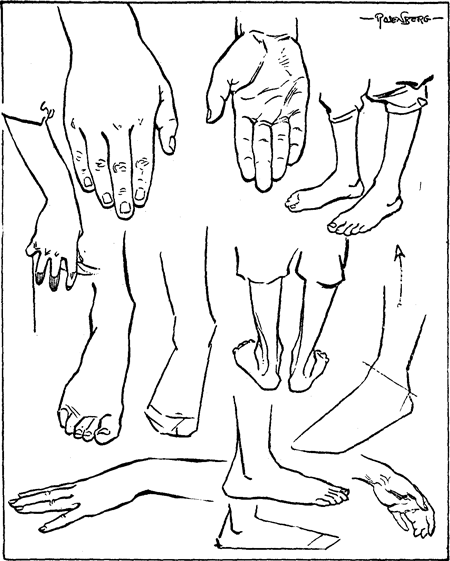Home > Directory of Drawing Lessons >How to Draw People > Hands > How to Draw Human Hands & Feet
DRAWING HANDS AND FEET LESSONS : How to Draw People's Hands and Feet
|
|
THE HANDS AND FEET : How to Draw ThemParticular attention should be given to a study of the hands, since this is the stumbling block over which most artists fall. Study the accompanying plates carefully, and sketch the bones of the hand—not once, but several times. Then, when you have become fairly familiar with the bones, practice drawing the skeleton hand each day, say for an hour. By this practice you will not only learn well the construction of the hand but also your memory will be strengthened. When you have learned the skeleton construction, then learn to draw the hand by the block method, described in another lesson. This method is well to use, for after you have blocked in the hand in the desired pose, you can develop the details more quickly and more correctly.
Top : Male Hand ... Bottom : Female HandPracticing drawing the hand from life, or a cast, will make it easier for you to draw it from imagination in making your cartoon or illustration. The average man's hand is usually large and well developed muscularly. If the hand to be shown is that of a laborer it should be depicted as short (stumpy), wide, and muscularly thick, the lines across the joints of the fingers very pronounced and the knuckles prominent. The veins on the back of the hand should be well defined, and the finger nails drawn large and square. The business man and the man of genteel labor have a longer, narrower, thinner hand, with the above mentioned details less pronounced.
The finger nails, are smaller, longer, and narrower, and somewhat oval in shape, with more grace in the pose than that of the workman's hand. The veins need not necessarily be defined. The female hand is long, narrow, thin, and tapering—the lady's hand delicate, the working girl's less so. Details, such as knuckles, veins and joint lines, should be discreetly omitted. On a domestic or a wash-woman's hand they can be shown, to a certain degree. In depicting esthetic, Greek and other classic dances the hand plays an important role. It must suggest grace, and therefore be drawn gracefully. To suggest this quality, handle your lines with curves, swinging the pose in somewhat as you would when sketching a graceful vine or a scroll design. The anatomy beneath is not obviously detailed, yet it must be apparent that it is there. Merely the outline of the hands is shown —usually suggested not necessarily drawn in detail.
Time leaves its impression upon the hands to a marked degree. An aged person's bones, knuckles, furrow lines, and veins are pronouncedly shown—to what extent depending upon the purpose. If it be a hand with no special action to suggest, it need not be particularly detailed beyond such obvious points as the knuckles, the joint lines, furrows, and perhaps a prominent vein or two. In the aged female hand you can dispense with the bony, defined outline—the knuckles, and the furrow lines of the finger joints being definitely drawn. Aged hands are best drawn with a fine pen—a Gillot 290, a Spencerian No. 12, or (for safety) a Gillot 170. These pens allow you to make a fine line and broaden it into a furrow when showing the finger furrows and the contour of the gnarled, shriveled hand. A baby's hand is equal to about one-third the size of its head. It is thick, chubby and round. The knuckle prominence becomes a dimpled dent. The veins are never shown, nor are the bones visible. Then, as the child grows older, the hands correspondingly develop, expand, and show more evidently the details of the hands' construction. The fingers lose their chubbiness and become longer and the hands tend to flatten out. Next to the hands, the student usually finds feet most difficult of all features to depict well. The simplest, easiest method of drawing the foot is to make the drawing by first blocking it in, as shown in the accompanying plate. The foot, facing forward, can be laid out somewhat resembling a triangle, the longest angle being on the inside. The profile view of the foot can also be blocked in with a triangle form, the longest side of the triangle in this view forming the base of the foot. After you have blocked in the general outline (triangle) of the front view, block in the location of the toes. After this preliminary work which, following a bit of practice, takes but a few seconds to accomplish, you can very quickly finish the drawing in detail. The shoe on the foot is difficult for the student to depict, mainly because of the lack of knowledge of the anatomy which it covers. After you have learned to draw the foot you will quickly learn to draw a shoe thereon. Use the same triangle method as you would in drawing the naked foot. Allow, in finishing the drawing, more toe and arch height, also a more pronounced heel. Over the toe face of the shoe draw an almost triangular form, tapering to the tip. The line across the seam should be drawn a bit curved, giving it a feeling of mounting over the form beneath it. |







